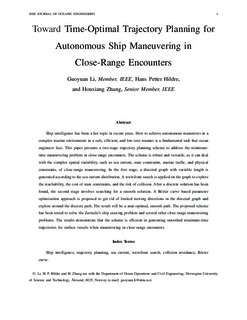| dc.contributor.author | Li, Guoyuan | |
| dc.contributor.author | Hildre, Hans Petter | |
| dc.contributor.author | Zhang, Houxiang | |
| dc.date.accessioned | 2019-09-24T10:58:42Z | |
| dc.date.available | 2019-09-24T10:58:42Z | |
| dc.date.created | 2019-09-23T10:56:51Z | |
| dc.date.issued | 2019 | |
| dc.identifier.issn | 0364-9059 | |
| dc.identifier.uri | http://hdl.handle.net/11250/2618461 | |
| dc.description.abstract | Ship intelligence has been a hot topic in recent years. How to achieve autonomous maneuvers in a complex marine environment in a safe, efficient, and low-cost manner is a fundamental task that ocean engineers face. This paper presents a two-stage trajectory planning scheme to address the minimum-time maneuvering problem in close-range encounters. The scheme is robust and versatile, as it can deal with the complex spatial variability, such as sea current, state constraints, marine traffic, and physical constraints, of close-range maneuvering. In the first stage, a directed graph with variable length is generated according to the sea current distribution. A wavefront search is applied on the graph to explore the reachability, the cost of state constraints, and the risk of collision. After a discrete solution has been found, the second stage involves searching for a smooth solution. A Bézier curve based parameter optimization approach is proposed to get rid of limited moving directions in the directed graph and explore around the discrete path. The result will be a near-optimal, smooth path. The proposed scheme has been tested to solve the Zermelo’s ship steering problem and several other close-range maneuvering problems. The results demonstrate that the scheme is efficient in generating smoothed minimum-time trajectories for surface vessels when maneuvering in close-range encounters. | nb_NO |
| dc.language.iso | eng | nb_NO |
| dc.publisher | IEEE | nb_NO |
| dc.title | Toward Time-Optimal Trajectory Planning for Autonomous Ship Maneuvering in Close-Range Encounters | nb_NO |
| dc.type | Journal article | nb_NO |
| dc.type | Peer reviewed | nb_NO |
| dc.description.version | acceptedVersion | nb_NO |
| dc.source.journal | IEEE Journal of Oceanic Engineering | nb_NO |
| dc.identifier.doi | 10.1109/JOE.2019.2926822 | |
| dc.identifier.cristin | 1727696 | |
| dc.relation.project | Norges forskningsråd: 237929 | nb_NO |
| dc.relation.project | Norges forskningsråd: 280703 | nb_NO |
| dc.description.localcode | © 2019 IEEE. Personal use of this material is permitted. Permission from IEEE must be obtained for all other uses, in any current or future media, including reprinting/republishing this material for advertising or promotional purposes, creating new collective works, for resale or redistribution to servers or lists, or reuse of any copyrighted component of this work in other works. | nb_NO |
| cristin.unitcode | 194,64,93,0 | |
| cristin.unitname | Institutt for havromsoperasjoner og byggteknikk | |
| cristin.ispublished | true | |
| cristin.fulltext | postprint | |
| cristin.qualitycode | 1 | |
